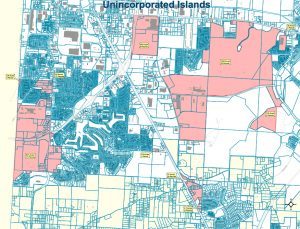Fort Smith Board weighs annexation on ‘unincorporated islands’ within city limits
by February 27, 2018 6:14 pm 1,276 views

The Fort Smith Board of Directors weighed on Tuesday (Feb. 27) the possibility of annexing into the city limits 10 “unincorporated islands” (just north of 2,600 acres). The areas range in size from 2.4 to 1,503 acres with the largest enclave including the 1,300-acre Ben Geren Regional Park owned and operated by Sebastian County.
Other major tracts include a 637-acre plot that includes portions of U.S. Highway 271 and Rutgers and Texas Roads; a 243-acre plot between Regions Park Drive and South 36th Street; and a 119-acre plot alongside Massard Road. Land uses within the 10 areas include recreational, residential, commercial, and industrial as well as vacant land.
Wally Bailey, the city’s director of development services, said the issue could be handled through petition or by placing it in front of voters. However, given the layout of these “islands” in relation to incorporated parts of the city, state law allows the Board to annex via “the ordinance method.”
Quoting Arkansas Code Annotated (A.C.A.) 14-40-501, Bailey said that “Whenever the incorporated limits of a municipality have completely surrounded an unincorporated area, the governing body of the municipality may propose an ordinance calling for the annexation of the land surrounded by the municipality.”
A.C.A. 14-40-501 through 14-40-504 details the procedures for annexing an enclave. These sections reference A.C.A. 14-40-302, which includes standards for lands qualifying for annexation. One standard is that contiguous lands “shall not be annexed if they are lands that do not include residents, except as agreed upon by the mayor and county judge.”
Bailey continued: “It is worth noting there are a couple of significant laws that will impact any area annexed into the city limits. The laws include the retail sale of fireworks and the discharge of firearms. When this issue was previously discussed, an amendment to the municipal code was approved that allows for the chief of police to issue permits allowing the discharge of firearms for entities such as the existing Pajaro Gun Club.”
On the retail sale of fireworks, city attorney Wyman Wade wrote to then-Fire Chief Mike Richards in July of 2010 discussing issues related to fireworks on any newly annexed lands in a three-page letter.

The city’s Engineering Department expects a cost of $1.7 million for the resurfacing of many streets in the affected areas, calling the current conditions “fair to good.” The Police Department report did not go into as much detail, but stated “the proposed annexation would impact coverage and response times.” The city’s Operations Department anticipates a $95,000 per year expense with no “one-time costs.”
The Fire Department noted four areas with a concerning lack of hydrants that would need to be addressed. These include the golf course clubhouse at Ben Geren Regional Park; 9700 block of Highway 271; Farm Bureau Insurance building and residents on Rye Hill Road East; and Columbus Acres.
“The city is currently providing some services in these areas by way of fire protection contracts, mutual aid agreements, and ownership of the water system,” Bailey said.
At-Large Director Kevin Settle said the city should consider “phasing in” the annexations, while Ward 1 Director Keith Lau mentioned the possibility of “impact fees” to affected areas for help with funding. Lau said he would not necessarily support such a fee himself, but it “needed to be part of the discussion” as the Board weighed its decision. Lastly, At-Large Director Tracy Pennartz asked the city to provide revenue projections for each enclave to help with future discussions.
